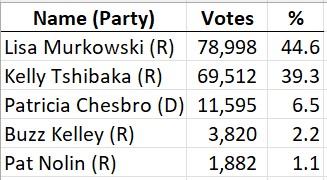More ranked-choice shenanigans in Alaska
The U.S. Senate race in Alaska has kicked up fresh controversy about the ranked-choice voting (RCV) method.
A number of local governments in Minnesota use a version of RCV. All candidates run in a single election, with voters ranking their top three (or more) choices. If no candidate gets a majority, then an “instant-run-off” takes place using voters’ 2nd and 3rd choice rankings, etc. Under this system, there is no primary election.
Back in 2020, the City of Bloomington voted narrowly to adopt the ranked-choice method for local elections. Some citizens on the losing end of that referendum have been trying to get a redo, to no avail. It appears to be a case of “one person, one vote, one time.”
The voting system currently used statewide in Alaska is slightly different: an open primary election to select the top four candidates (regardless of party) that voters will rank 1 through 4 in a general election.
Alaska held its primary election earlier this month and here are the top five vote getters for the U.S. Senate contest:

The above are unofficial results, with mail ballots still trickling in. Of the 19 candidates in the race, only the above five received more than one percent of the vote. Four of the five were Republicans. The incumbent Senator, Lisa Murkowski, received the most votes, but fell short of a majority in the crowded field.
In a standard primary system, Murkowski (R) would face Chesbro (D) in the November election, with Murkowski the overwhelming favorite.
Under the open primary system used in California, only the top two candidates would have advanced to the November general election, guaranteeing a Republican senator, in this instance. Under Alaska’s RCV system, it is possible that the Democrat could squeak through, based on 2nd and 3rd choice votes, despite the state’s clear preference for a Republican.
How ironic, since it was Murkowski herself who was a big (if quiet) supporter of the RCV law. James O’Keefe’s Project Veritas aired an expose to that effect right before the Alaska primary this month.
The incumbent Murkowski is said to favor RCV as it should benefit her re-election chances, as the most well-known candidate in the race. At this point, it stands as the only remaining obstacle to her return to Washington.
One of the Murkowski campaign staff quoted in the Project Veritas video had this to say about ranked-choice voting:
“They framed it [Ballot Measure 2, RCV] basically, you know, ‘This gives you more choice’ — ‘This makes it so we have better candidates.’ And I think it helps progressive candidates…If it was [called] a progressive measure, it wouldn’t really work,” he said.
We may not know who won in Alaska for some time. The state will count mail ballots that arrive up to 15 days after election day. Only then will they begin tallying 2nd, 3rd, and 4th choice votes.